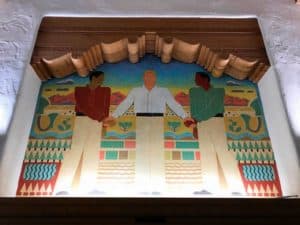University Head Recommends Covering Controversial Murals
Mary Hudetz, Associated Press, October 8, 2108
{snip}
For decades, the Great Depression-era mural on the University of New Mexico campus in Albuquerque and the white man’s place at the center of it have irked numerous faculty members and students, who say the scene it depicts marginalizes the state’s two largest minority groups. Painted in 1939, it is one of four “Three Peoples” murals commissioned under the federal Public Works of Art Project for the school’s Zimmerman Library.
Now, the university’s president and provost are recommending that curtains cover all four murals as a campus dialogue continues on them, said Alex Lubin, who is the school’s associate provost for faculty development. The proposal from President Garnett Stokes and Provost Richard Wood must next go before the Regents Historic Preservation Committee.
If approved, it would mark the latest change made by the university in response to concerns raised by Native American faculty and student groups over symbolism, art and celebrations on campus.
{snip}
Lubin was tasked recently with convening a task force on how to address decades-old concerns over the murals by Kenneth Adams, the artist who had lived in Taos. There also have been student groups — including the Kiva Club, which represents Native American students — that have expressed their opposition to the murals, following decades of protests against them.
{snip}
The students also had pushed for several years for the school to recognize Indigenous Peoples’ Day instead of Columbus Day, which happened on campus for the first time Monday, Minthorn said.
Last year, administrators suspended use of an official University of New Mexico seal that had been etched with the profiles of a frontiersman and conquistador — two groups viewed as having a part in the historical mistreatment of Native Americans in the state.
{snip}

One of four murals being covered. Images of the other three are available with the original story.
The first scene in the set of murals shows five Native Americans with a weaving loom at the center. One woman is at work on a basket. Another wears silver and turquoise jewelry. The imagery was intended to serve as a nod toward the traditional arts and crafts of tribes.
In the next mural, two Hispanic women are at work on an adobe building, while a man labors in a field. The scene is meant to pay tribute to Hispanic contributions in agriculture and architecture.
The third mural centers on science, with a man and woman — both blond — hovering over desks with a microscope and other machinery. A white doctor holds a baby.
The mural with the white man flanked by Hispanic and Native American men is last in the series.
“The murals themselves present a very racialized perspective of who is in authority,” said Glenabah Martinez, a Native American professor and associate dean in the university’s Language, Literacy and Sociocultural Studies department. “It was about the portrayal of how the racial hierarchy works in New Mexico.”















